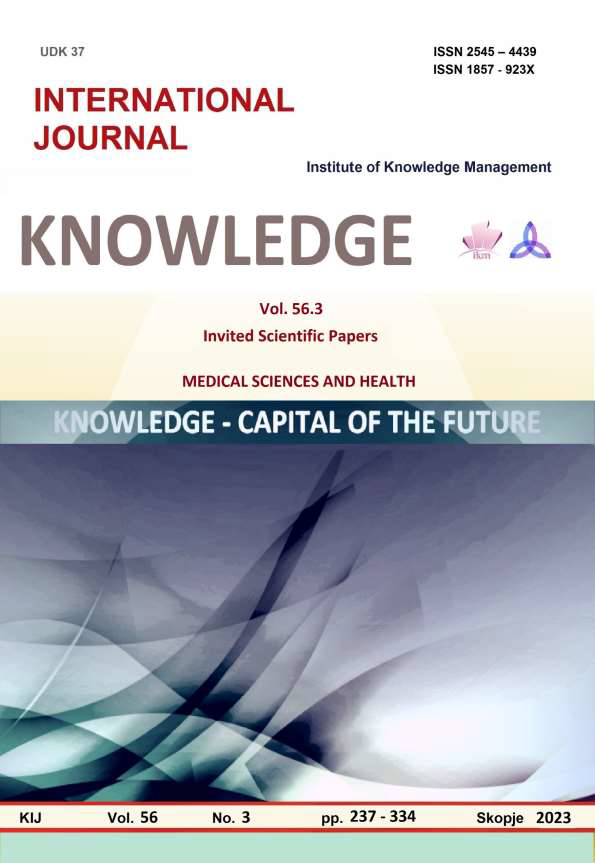CONSEQUENCES DUE TO THE PRESENCE OF WORK-RELATED MUSCULOSKELETAL DISORDERS IN THE AREA OF THE LOWER BACK AND CERVICAL SPINE AMONG PHYSIOTHERAPISTS
Keywords:
lumbar spine, cervical spine, musculoskeletal disorders, physiotherapists, work relatedAbstract
The purpose of the article is to present the consequences due to the presence of work-related
musculoskeletal disorders in the area of the lower back and cervical spine among physiotherapists in
Montenegro.One hundred twenty-seven physiotherapists performed the general questionnaire and modified Nordic
survey questionnaire. Statistical analysis was performed using the IBM SPSS Statistics version 20. The significance
level was set up to p < 0.05.
The most frequent painful region among physiotherapists was the lower back (66.1%), followed by the cervical
spine (58.3%). Due to the presence of symptoms in the area of the lower back, 54.8% of respondents took therapy,
50% of respondents reduced their activities, 10.7% of respondents missed one or more working days, while 3.6% of
respondents changed their workplace. Due to the presence of symptoms in the area of the cervical spine, 60.8% of
respondents took therapy, 35.1% of respondents reduced their activities, 6.8% of respondents missed one or more
working days, while 1.4% of respondents changed their workplace.
The results of our research showed the consequences due to the presence of work-related musculoskeletal disorders
in the area of the lower back and cervical spine among physiotherapists in Montenegro. This includes taking therapy
due to the presence of symptoms, reducing activity due to the presence of symptoms, missing one or more working
days due to the presence of symptoms, and changing workplaces due to the presence of symptoms.
It is recommended to apply a prevention strategy that should be formed simultaneously on 3 levels: valid legal
regulations and guidelines for organizing the work environment of physiotherapists, by adjusting the organization
and ergonomics of the workplace and education of physiotherapists
References
Abu-Taleb, W., & Rehan Youssef, A. (2021). Work-related musculoskeletal disorders among Egyptian physical therapists. Bull Fac Phys Ther 26, 7 (2021). Dostupno na: https://doi.org/10.1186/s43161-021-00025-z.
Alperovitch-Najenson, D., Treger, I., & Kalichman, L. (2014). Physical therapists versus nurses in a rehabilitation hospital: comparing prevalence of work-related musculoskeletal complaints and working conditions. Arch Environ Occup Health. 2014;69(1):33-9. doi: 10.1080/19338244.2012.719555. PMID: 23930794.
Gohere, P., & Koley, S. (2021). PREVALENCE OF WORK RELATED NECK PAIN IN GIRL PHYSIOTHERAPY STUDENTS OF AMRITSAR. International Journal of Medical Science And Diagnosis Research, 5(6). https://doi.org/10.32553/ijmsdr.v5i6.803
Hossain, M.D., Aftab, A., Al, Imam, M.H., Mahmud, I., Chowdhury, I.A., Kabir, R.I., & Sarker, M. (2018). Prevalence of work related musculoskeletal disorders (WMSDs) and ergonomic risk assessment among readymade garment workers of Bangladesh: A cross sectional study. PLoS ONE13(7): e0200122. https://journals.plos.org/plosone/article?id=10.1371/journal.pone.0200122
Khairy, WA., Bekhet, AH., Sayed, B., Elmetwally, SE., Elsayed, AM., & Jahan, AM. (2019). Prevalence, Profile, and Response to Work-Related Musculoskeletal Disorders among Egyptian Physiotherapists. Open Access Maced J Med Sci. 2019;7(10):1692-1699. Published 2019 May 17. doi:10.3889/oamjms.2019.335
Meh, J., Bizovičar, N., Kos, N., & Jakovljević, M. (2020). Work-related musculoskeletal disorders among Slovenian physiotherapists. Journal of Health Sciences. Available at: https://doi.org/10.17532/jhsci.2020.880
Munir Ahmad, M., Khan, L. ., Niazi, M. N. ., Fajir, N.- e-., & Fatima, H. (2022). Work Related Musculoskeletal Disorders among Physical Therapist Living in Pakistan: Cross sectional Survey.Pakistan Journal of Rehabilitation, 11(1), 155–163. Retrieved from http://ojs.zu.edu.pk/ojs/index.php/pjr/article/view/1387
Prerana, S., Saravanan, M., Krunal, L., Krishna, R., & Ruchi, V. (2016). Prevalence, job risk factors and coping strategies of Work Related Musculoskeletal Disorders among Physiotherapists. International Journal of Occupational Safety and Health, 6(2), 6–12. https://doi.org/10.3126/ijosh.v6i2.22526.
Rahimi, F., Kazemi, K., Zahednejad, S., López-López, D., &Calvo-Lobo, C. (2018). Prevalence of Work-Related Musculoskeletal Disorders in Iranian Physical Therapists: A Cross-sectional Study. J Manipulative Physiol Ther. 2018 Jul-Aug;41(6):503-507. doi: 10.1016/j.jmpt.2018.02.003. Epub 2018 Aug 8. PMID: 30098820.
Ullah, S., Wahab, I., Saram, M., Farooq, U., & Burki, S.R. (2019). Prevalence of burnout among physical therapists working in Peshawar. Northwest Journal of Medical Sciences
Vieira, ER., Svoboda, S., Belniak, A., Brunt, D., Rose-St Prix, C,, Roberts, L., et al. (2016). Work-related musculoskeletal disorders among physical therapists: an online survey Disabil Rehabil, 38, pp. 552-557.
Vieira et al. (2016). Work-related musculoskeletal disorders among physical therapists. Journal of Back and Musculoskeletal Rehabilitation, vol. 29, no. 3, pp. 417-428.





